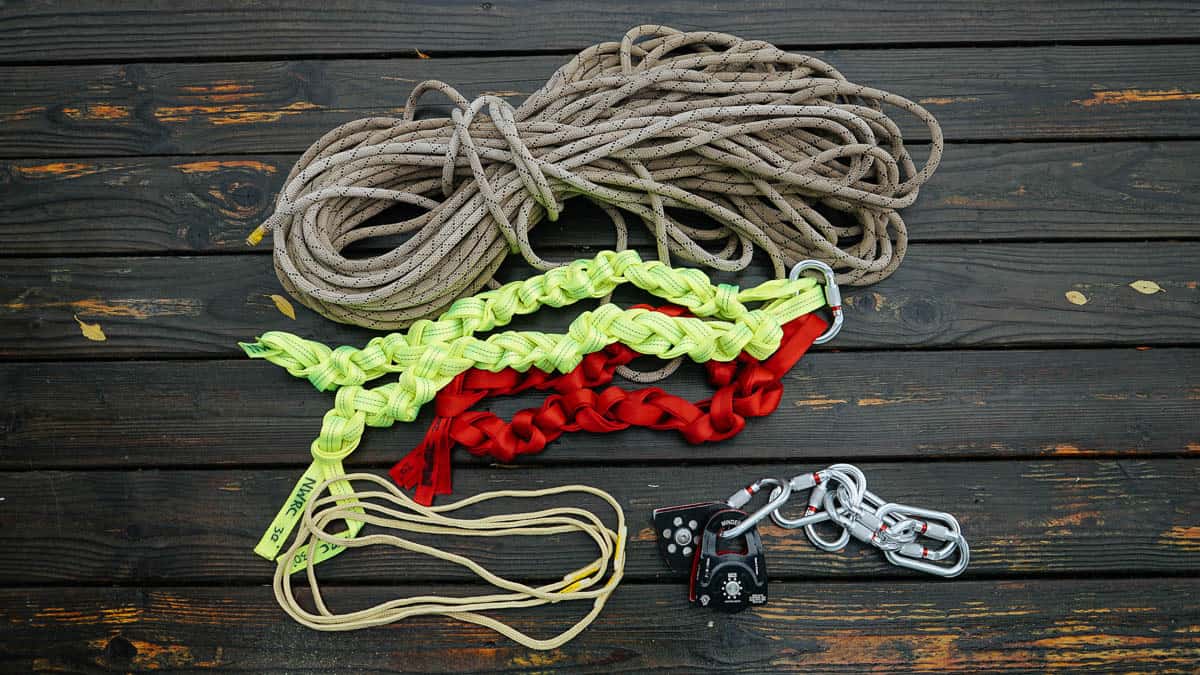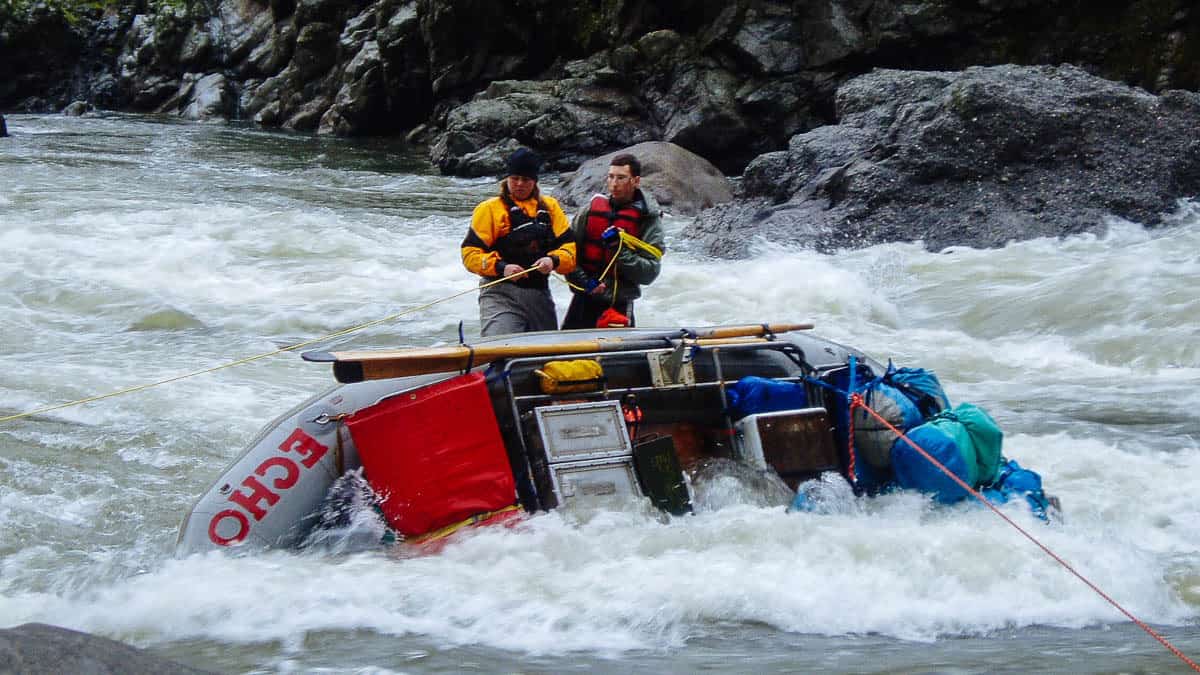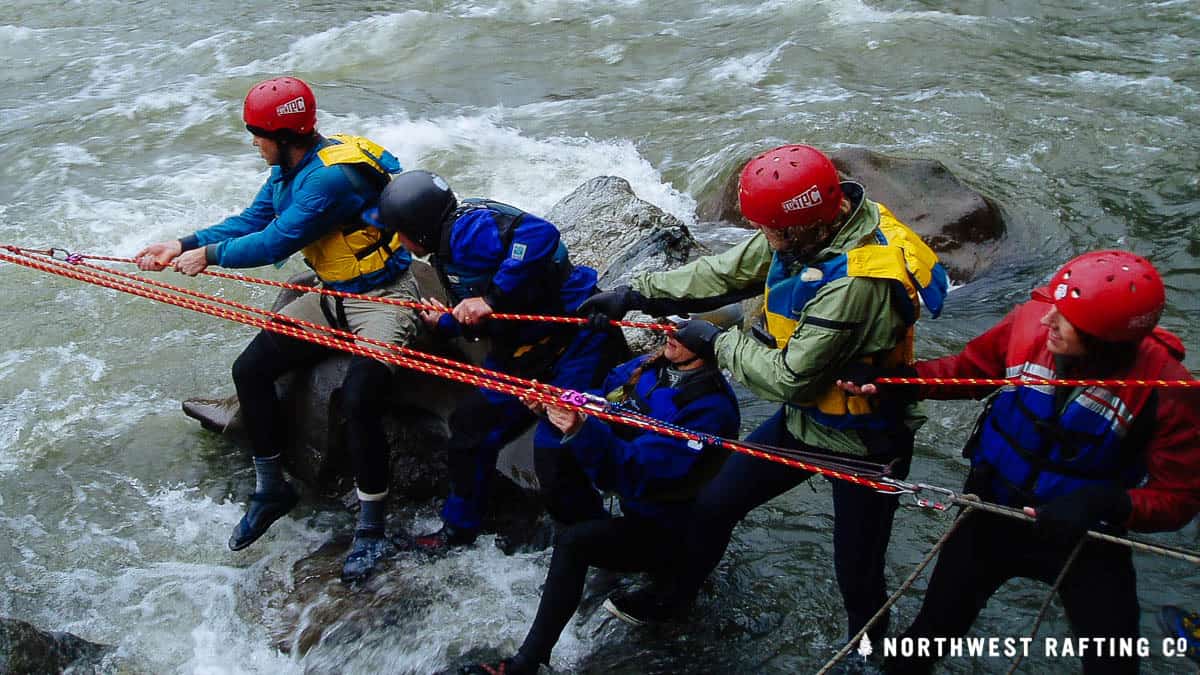This article details items that outfitters and guides commonly carry in their safety kits. These items are commonly used to pull boats that are wrapped or pinned, so they are sometimes referred to as wrap kits, z-rig kits, or pin kits.

I suggest whitewater rescue training to get the best use out of these tools, all of which can be used for simple mechanical advantage systems, telfer-lower systems, 4:1 Pig Rigs, and/or 3:1 Z-rigs. In my opinion, the most important safety tool is the throw bag, which can be used to secure a swimmer or pull on wrapped or pinned boats.
The exact contents of my safety kit depends on the river I’m doing and the type of boats on the trip. Here’s a full list of items I bring on multi-day trips with big, heavy gear boats.
Heavy Duty Safety Kit Checklist
- 200′ Safety Line
- 8 Locking Carabiners
- 2 Each of 20-foot and 30-foot Sections of Tubular Webbing
- 3 Pulleys
- 3 Prusiks
150 – 200 Feet of Safety Line
A safety line is the key ingredient of any safety kit. It should be strong, but its most important characteristic is that it has very little elongation (minimal stretch) when pulled on. When using a line with minimal stretch most of the force applied to the rope will be transmitted to the raft instead of stretching the rope.
Safety lines vary from 3/8-inch (10-mm) to 1/2-inch (12-mm) in diameter. You can choose between Nylon core static lines or Polypropylene core ropes. Polypropylene ropes (often found in throw bags) tend to stretch more, causing energy to be lost with each tug. The Nylon rope is typically twice as strong as the Polypropylene, but it doesn’t float.

Another option for your safety line would be Spectra or Dyneema rope. These are both high-tech ropes that are incredibly strong and stiff. A 3/8-inch Dyneema line is typically stronger than a 1/2-inch nylon core line, which makes for a nice compact and strong line that takes up less space in your safety kit. The downsides of Dyneema or Spectra are that they are more expensive and these smaller diameter ropes are harder to grip (it’s generally easier to grip thicker ropes). Also note, that If you use a smaller diameter rope, then you’ll need smaller diameter prussics.
8 Locking Carabiners
A 3:1 mechanical advantage system (also known as “Z-Rig” or “Z-Drag”) can be set up with a minimum of 4 carabiners, but you often need more for most rescue or pin situations. You should only use locking carabiners for river rescue.
2 Each of 20-foot and 30-foot Sections of Tubular Webbing
Tubular webbing (AKA hoopie) is used for setting anchors on rocks, boats, and trees. Webbing can also be used to tie rescue harnesses to people. It’s very strong and very easy to work with. It takes at least 20 feet of webbing to create a self-equalizing anchor using two D-rings on a raft. It takes at least 30 feet to use 3 D-rings. If you find yourself in need of 15 feet (or less), you can always cut your 20 or 30-foot sections into smaller lengths.
3 Pulleys
Pulleys are used to reduce the friction on ropes when the pull-direction is changed. A common use is the 3:1 “Z-Rig” which requires 2 pulleys to set it up and a 3rd pulley to change the direction of the pull.
Pulleys have many uses beyond Z-rigs. You can create a 2:1 mechanical advantage by simply putting a pulley on the object (typically a raft) you’re trying to move. They can also be used to change the direction you’re pulling if there is a tree, cliff, or rock hindering the direction you need to pull. If you need to set up a tefler-lower system to rescue someone in the river or to get a raft to an injured person, you’ll want to have at least 4 pulleys.

4 Prussics
Prussics are loops of rope that can be pre-sewn or connected with a double-fisherman’s knot. They can be connected to larger ropes by using a prussic hitch, which allows flexibility to move the attachment point. The primary purpose of prussics is to attach pulleys and brakes to your static line when setting up mechanical advantage systems.
In theory, if the diameter of your prussic is half the diameter of your static line, it will likely slip from the static line before it breaks. This is a good thing because when a prussic breaks it’s usually violent and can cause serious injury, so you would prefer it to slip rather than break. I like to use 11 mm static line with 6 mm prussic line.
Safety Training
There is no substitute for proper training. Keep in mind that 30% of all victims are the rescuer. A rescue class will teach you safer methods for removing wrapped boats, and more importantly, systems for stabilizing and freeing a trapped swimmer.

